Carl Nielsen & His Quintet
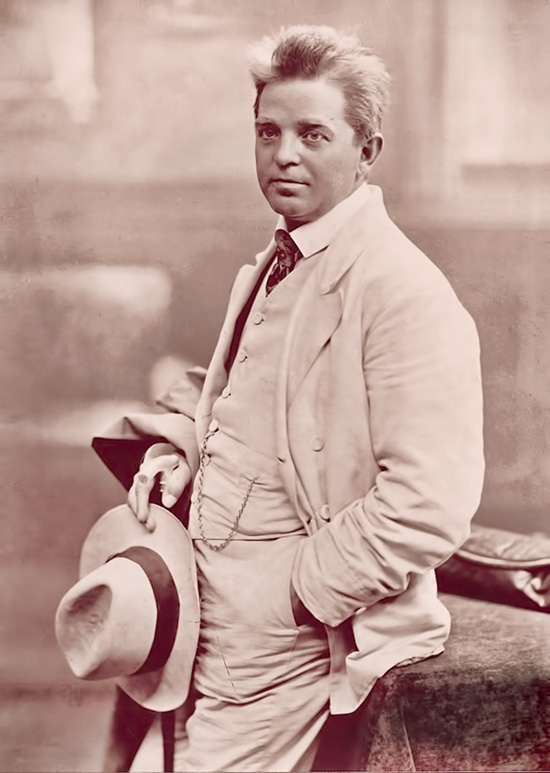
Which Quintet Came First — Nielsen or Hindemith?
Chronologically, it was a close call whether to start this in -depth composer series with Nielsen or Hindemith. Technically, Carl Nielsen’s Quintet was first performed privately on April 30, 1922. This predates the first performance of Hindemith’s Kleine Kammermusik No. 2 of June 12, 1922 by just six weeks. However, the first public performance of Nielsen’s work had to wait until the following October 9th in the smaller hall of the Odd Fellows Mansion in Copenhagen. It’s curious that these two works, which were to become two of the most popular wind quintets ever written, were being composed at virtually the same time by two composers who were highly unlikely to have known much of the other.
Nielsen’s Early Life & Career
Carl August Nielsen (born June 9, 1865; died October 3, 1931) was the seventh of twelve children who grew up in the island of Funen in Denmark to poor but musically talented parents: Maren Kirstine Jørgensen, née Johansen (1833-1897) and Niels Jørgensen (1835-1915). Young Carl started learning the violin at age six, but also learned bugle and alto trombone and performed as a musician in a military band (with the army’s 16th Battalion) when still fourteen, which paid very modestly (including a loaf of bread every five days). He even worked for a while as a shepherd to help the family make ends meet.
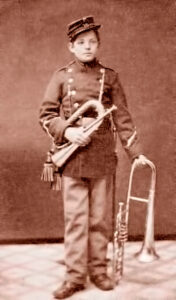
With aid he was able to attend the Copenhagen Conservatory of Music (later re-named the Royal Danish Academy of Music) and studied composition with the Danish composer Niels Gade and music theory with Orla Rosenhoff (who also nurtured Nielsen’s composition career after graduation). All in all, he was a good but not outstanding student. He continued to be diligent with his violin studies and began working as an orchestra violinist.
He eventually won a grant giving him an opportunity to tour Germany, France and Italy. In Paris, in 1891, he met a fellow-traveler, the Danish sculptor Anne Marie Brodersen. They toured Italy together and married in Florence. The marriage was tumultuous, and the two separated in 1919. (But they reconciled in 1923.)
He worked as a violinist, composer, conductor, and teacher, slowly getting his works accepted by the public, and gradually making a living as a composer. Later in life he became Director of the Royal Conservatory. A fuller timeline of his life is available on CarlNielsen.org.
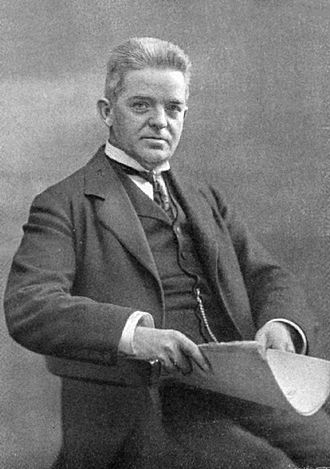
About Carl Nielsen’s Quintet
Kvintet (Quintet), Op. 43
- Allegro ben moderato
- Menuet
- Praeludium – Tema con variazioni.
Written for flute, oboe doubling on English horn, clarinet, horn and bassoon.
Thanks to the Danish Carl Nielsen Society and their website, we actually know a lot about the creation of this quintet.
The work might not have been written except for the fortuitous timing of a phone call. In 1921, Nielsen phoned the pianist Christian Christiansen at the very moment he was rehearsing the Mozart Sinfonia Concertante with four of the members of the Copenhagen Wind Quintet (the Københavns Blæserkvintett). While Christiansen talked, the wind players kept on rehearsing and Nielsen asked if he could come over and listen. He got to know both the Mozart work (which itself has an odd history) as well as the members of the quintet. Later, he told the oboist, Svend Christian Felumb, that he wanted to write a quintet for them.
Nielsen began composing the Quintet on Feb. 1, 1922, while in Gothenburg on a conducting assignment. (He had just finished his Fifth Symphony.) The next month, Nielsen was conducting a performance of Hector Berlioz’s Symphonie fantastique in Copenhagen with no other than Felumb, again, performing the off-stage English horn solo. After the concert, in the middle of the night, Nielsen phoned Felumb to ask him if it was possible for an oboist to switch back and forth from oboe and English horn in the middle of a work. (Apparently, doubling wasn’t as common in Denmark in 1922 as it is today.) Felumb said that it was possible, which led to the use of the solo English horn in the third movement of the Quintet.
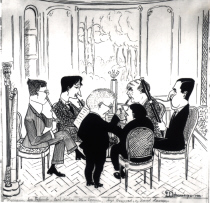
The quintet was first performed privately on April 30, 1922, in the home of Herman and Lisa Mannheimer in Gothenburg, Sweden, with Paul Hagemann on flute; Svend C. Felumb on oboe; Aage Oxenvad on clarinet; Hans Sørensen on horn, and Knud Lassen on bassoon. It was not scheduled to be performed in concert, however, until October 9, 1922, in the smaller hall at the Odd Fellows Mansion in Copenhagen. (The Mansion, which includes an auditorium, was built in the 1750s and remains a landmark.) The delay in performing was probably due to the summer break in the concert season, but it surely didn’t help that Nielsen suffered a heart attack that July. (It was part of a series of heart problems that later led to his death.)

Even after the performance, Nielsen had some problem getting the quintet and several other works published. (Unlike today, composers didn’t have the technology to self-publish.) His main publisher, Wilhelm Hansen, was no longer publishing everything that Nielsen wrote and thus, C. F. Peters in Germany published several works. But Hansen did, eventually decide to publish the Quintet in 1923 and this is the edition still in print a century later.
More About the Quintet
For those not familiar with this piece, Carl Nielsen’s Quintet, Op. 43 is in three movements. The first (Allegro ben moderato) is clearly in a traditional sonata-allegro form. The second movement is a Menuet, an even older dance form than the Waltz found in the Hindemith quintet. The Menuet features extended duets with the clarinet and bassoon, keeping the textures simple.
The final movement (Preludium – Tema con variazioni) is the movement that most endears itself to the players. The theme is based on a hymn that Nielsen wrote “Min Jesus, lad mit Hjerte faa” (“My Jesus, Make My Heart to Love Thee”) from his collection Halvthundrede Salmer.
With his conducting activities, being Director of the Royal Conservatory, and the relatively small community of classical musicians in Denmark and Scandinavia, it seems likely that Nielsen had contact with the quintet’s musicians before that famous rehearsal of the Mozart work. As a result, Nielsen appears to have considered the personalities of the players as well as their technical abilities while composing the Quintet.
Formally, the quintet clearly is based on classical forms, even as Nielsen adds some piquant harmonies. The work is not as adventurous as the Hindemith, Schoenberg, or Villa-Lobos quintets written in the same decade, each of which create a new sound-space never heard before in a quintet. Instead, where Nielsen shines is in brilliant use of melody supported by traditional but well-though-out harmony, and a working knowledge of the technique of each of the five instruments. It also reflects the pure joy of composing and, for the quintet members, of performing.
The first movement is a classical sonata-allegro form, with the melody first begun by the bassoon at the beginning. What is notable is how deftly Nielsen weaves the different instruments together to highlight their distinct timbres and personalities with the musical material.
The second movement is simplicity itself, with a Minuet and Trio form, first an extended melody by the clarinet accompanied by the bassoon and later the flute and oboe. The Trio section is built on top of a simple canon performed by oboe, clarinet, flute and bassoon.
The first two movements of the Quintet are, in the whole, light exercises in melody, counterpoint, and orchestration. Beautifully done, of course, and fun to perform, but not overly dramatic. This changes in the finale, which makes some big demands on the players as well.
From it’s first notes, the English horn adds a new level of drama and the Praeludium announces that this is something very different from the earlier movements. It also gives the oboist an entirely new way to show their virtuosity. The flute and clarinet also do their part to paint a new mood with the minor key.
The beginning of the chorale changes the mood and presents the simple theme from which the rest of the movement builds upon. The music is actually a hymn that Nielsen had written before in a collection of 50 chorales. This theme is followed by eleven variations and then ends with a restatement of the original theme, which is itself another variation.
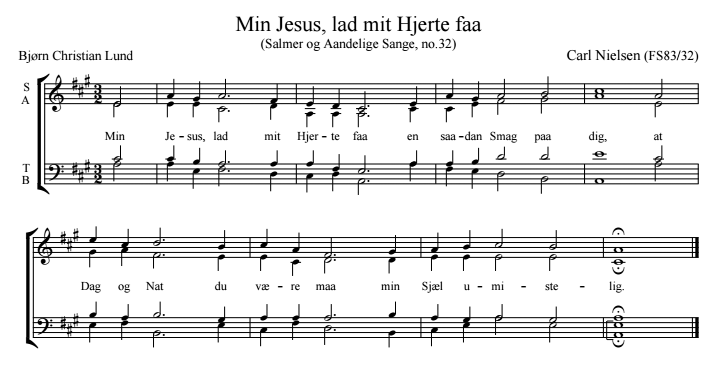
Nielsen’s hymn, Min Jesus, lad mit Hjerte faa, the source of Nielsen’s theme for the last movement of the Quintet.Text is by Bjorn Christian Lund (1738-1809).
The 1st Variation is a duet between the horn and bassoon with the horn leading majestically and the bassoon in a supporting role. (The variation also gives the oboist plenty of time to switch back from English horn to oboe.)
The 2nd Variation gives the flute a virtuosic-sounding turn, supported by the rest of the ensemble.
The 3rd Variation gives the melody to the oboe in a mostly somber mood, with the ensemble fighting over whether we’re in a major key or a minor key.
Variation 4 changes the mood with a bright and lively scherzando for the entire ensemble, which ends almost as quickly as it begins.
The 5th Variation is the most humorous part of the finale which Nielsen apparently based on the character of the two musicians he wrote it for. We witness a musical argument between the bassoon, initially droning on a repeated 2-note pattern, while the clarinet plays circles around it, arguing vociferously, probably just for the sake of arguing. The discussion gets heated, but when the clarinet victoriously finishes his argument, the bassoon still gets the last word. (Modern interpretations may include some clowning around between the two players as well.)
Just to remind us how far we’ve strayed from the original idea, the 6th Variation brings the original theme back, but in a somber minor key.
The 7th Variation is entirely a bassoon solo, giving the player complete freedom to interpret the rolling triplet variation.
The bassoon and horn play a single open fifth interval throughout the 8th Variation to accompany a mournful, oriental-sounding oboe melody while the other winds join in periodically to support.
After the somber mood of the previous three variations, the horn gets to add nobility in a solo 9th Variation.
The flutist leads the 10th Variation in a much sunnier disposition, once and for all leading us out of the weeds of minor keys and somber horn solos. The flute is accompanied at first by just the bassoon, but the rest of the ensemble enters to support the change. (Which is secretly building up to the ending.)
The 11th Variation is a festive march for the entire ensemble, with its own coda which starts bright and virtuosic, accelerates, and then slows to bring back the original theme to end the piece. Even the return to the chorale is a variation, now in 4/4 meter instead of the original 3/4. The change of meter gives the original theme a sense of majesty at the end, which, personally, never fails to instill some emotion in this old bassoonist.
The quintet for winds is one of the composer’s latest works, in which he has attempted to render the characters of the various instruments. At one moment they are all talking at once, at another they are quite alone. The work consists of three movements: a) Allegro, b) Minuet and c) Prelude – Theme with Variations. The theme for these variations is the melody for one of C.N.’s spiritual songs, which has here been made the basis of a set of variations, now merry and quirky, now elegiac and serious, ending with the theme in all its simplicity and very quietly expressed.”
Carl Nielsen’s original program notes, (translated in the English version of Wikipedia), writing about himself in the third person.
There were several performances of Nielsen’s Quintet during his short, remaining lifetime, including a notable one at the International Music Week in Berlin on March 29, 1923.
As a postscript, after he died, Nielsen’s funeral was a national event. All the music played at the extended service was written by the composer himself. After the funeral and procession to the burial site, the Chapel Royal’s Wind Quintet played the final chorale of Nielsen’s quintet while his coffin was lowered into the ground.
Other Nielsen Works for Winds
Although Nielsen only wrote one woodwind quintet, he did intend to write a concerto for each of the original five musicians who performed this work. Unfortunately, death took him in 1931 after completing only the flute and clarinet concertos.
There is also another quintet, Serenata in Vano, for clarinet, bassoon, horn, cello and double bass.
One of his earlier works was two Fantasy Pieces for Oboe and Piano, listed as Opus 2, although he had written a fair number of pieces by then.
More info Online
If you want a formal analysis of Nielsen’s Quintet, you might look at Ray Ashley’s analysis which is pretty good. Wikipedia also has a good article about this piece, largely based from info from the Carl Nielsen Society.
Again, for more info on Nielsen, the Carl Nielsen Society website is in both Danish and English and has an extensive biography of the composer. Much of what we know about the circumstances of writing the Quintet is from this source.
Also, CarlNielsen.org offers a 150th Anniversary retrospective of Nielsen’s life and music.
Online recordings:
Although there are many commercial recordings of the Quintet, there are also some very good performances on the web, too.
The recording by the Carion Quintet on their website is special on many levels. First, it is an excellent performance of the work. Second, it’s a classical music quintet performance designed for the video age. Third, they perform the entire work by memory (as they regularly do in concerts). This frees them from all the stage props of chairs and stands as they move about. Fourth, as part of the video production, they perform this work in a gorgeous, well-lit museum room filled with sculpture. Finally, as a consequence of memorizing the work and performing regularly, they KNOW this piece intimately, making it arguably one of the best recordings available of Nielsen’s Quintet. Did we mention that Carion is a Danish quintet playing a work by a Danish composer? The members of the Carion Quintet are Dóra Seres, flute; Egils Upatnieks, oboe and English horn; Egīls Šēfers, clarinet; David M.A.P. Palmquist, horn; and Niels Anders Vedsten Larsen, bassoon.
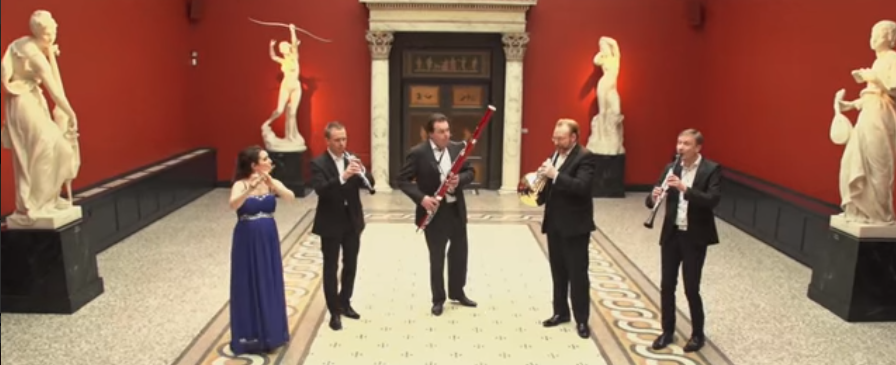
Another All-Danish recording of the quintet is by The Danish National Symphony Orchestra Wind Quintet, with Ulla Miilmann, flute; Eva Kruse Steinaa, oboe and English horn; Johnny Teyssier, clarinet; Lasse Mauritzen, french horn; and Audun Halvorsen, bassoon. The ensemble, performing/recording in their concert hall, takes more time to luxuriate in the sound of the house, which especially pays off in the solo horn variation of the finale.
CarlNielsen.org offers a 150th Anniversary retrospective of Nielsen’s life and music, including sound files of a commercial recording of the Quintet on Dacapo Records by The Scandinavian Wind Quintet, with Mads Johansen, flute; Klas Sjöblom oboe and English horn; Jesper Helmuth Madsen, clarinet; Peter Andersen, bassoon and Ola Nilsson, horn.
Around 2016, I accidentally came across another YouTube recording of Nielsen’s Quintet, performed by the musicians who Nielsen wrote the work for (except that the original flutist had retired and is replaced by Gilbert Jespersen). It was recorded on January 24, 1936, for the RCA Scandinavian Red Label series and may be the first recording ever made of this quintet, which took 7 ½ sides of 78 rpm discs. Possibly recorded in one take, the audio is not of top quality and, frankly, neither is the performance. The sound of the reed instruments, particularly, is of an older style. But the opportunity just to get an idea of the sound of the first performers makes this fascinating, historically.
Credits
The Nielsen photo (holding hat) is dated from 1907 and available from a Google Image search. (No source info is available.)
The photo of a young Nielsen with signal horn and alto trombone is dated 1879. There are several sources (including Wikipedia), but the most original digitized version may be from carlnielsen.dk.
The photo of Nielsen holding a musical score is dated 1917. It is from Wikipedia, but the original was published in the 1917 book, Danske komponister i det 20. aarhundredes begyndelse : med portræter og faksimilenodetryk efter komponisternes manuskripter.
The cartoon of Carl Nielsen with the woodwind quintet was made in 1922 by P. E. Johannessen on the occasion of the first performance of the Quintet. From the Carl Nielsen Society website.
Carl Nielsen’s hymn, Min Jesus, lad mit Hjerte faa excerpt is Copyright © 2006 by Choral Public Domain Library. Accessed from the International Music Score Library Project, imslp.org.
The screen shot of the Carion Quintet performing the Nielsen Quintet is from their website, carion.dk.
The image of the Odd Fellows Mansion, where the Quintet was premiered, is from visitdenmark.com.
All photos were, in various degrees, adjusted, cropped and sometimes cleaned up for web display using Photoshop and Topaz Labs plugins.
Copyright © 2016-2024 by Andrew Brandt
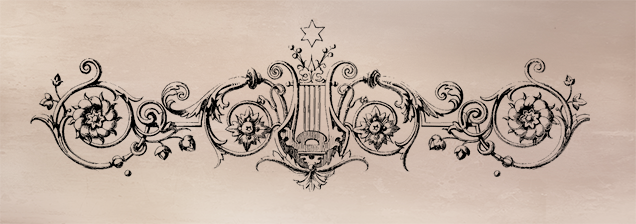

It’s great that you’re back. I was worried there for a while that the site would disappear! An invaluable resource.
It took a lot of work, but the new site should be an improvement. Thanks for the comment.